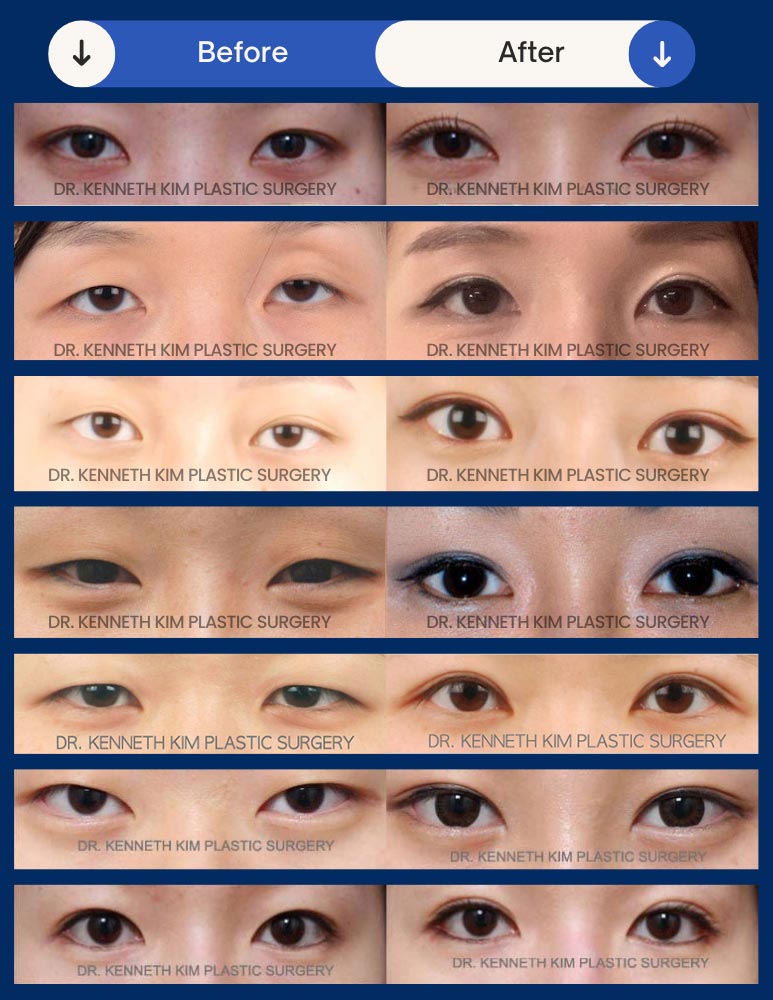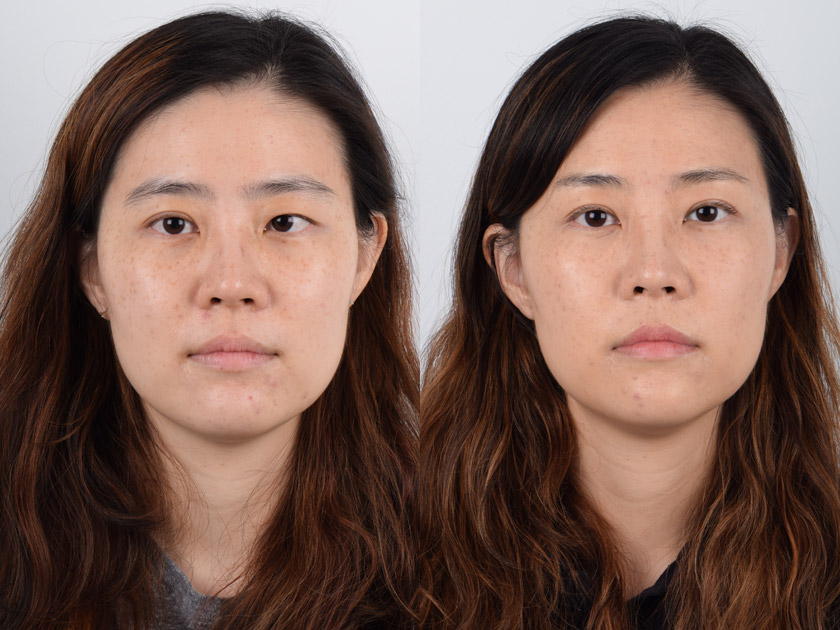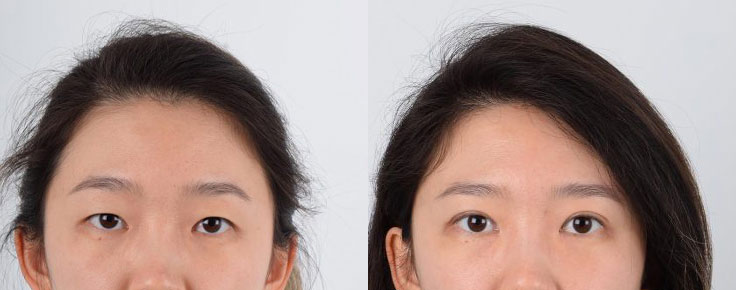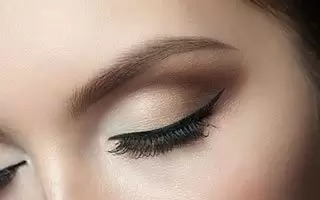Eyelid Surgery in Los Angeles
Serving the areas of Los Angeles and Beverly Hills with a global patient base

In recent years, eyelid surgery has become much more detailed and focuses on balancing the patient’s face as a whole. This comprehensive approach can deliver improvements like eye enlargement while also enhancing an alert, dynamic expression. Dr. Kim’s approach to eyelid surgery draws patients across the country (and world) for transformative results that last.
About Eyelid Surgery
Also referred to as blepharoplasty, eyelid surgery is a type of plastic surgery focused on improving the appearance of the eyes. While nothing is done to the eye itself in this procedure, it is ideal for crafting the appearance of wider, more youthful eyes. Signs of aging or genetics can both contribute to eyelids that create an appearance at odds with your ideal self. Through precise adjustments to the eyelids, blepharoplasty can provide benefits such as:
- Eye enlargement
- Removal of excess skin
- A more alert expression
- Reduced eye bags
- A youthful appearance
- Removal of dark circles
- And more
Why Do Patients Undergo Eyelid Surgery?
People may wonder why there is so much interest surrounding eyelid surgery. In short, patients choose eyelid surgery because bigger, brighter, more alert eyes are among the features attributable to the criteria of universal beauty. The eyes are a prominent feature that can be distinguished from the rest of the face and body because of its dynamic properties. Additionally, the eyes play a pivotal role in expressing personality, emotions, and the inner workings of a human being.
As such, eyes are unique to each individual and should not be copied from patient to patient. They should be customized and tailored to the patient’s unique facial features and optimized for facial harmony and balance. The eyelid surgeon should be fully aware of this and offer surgical sensibility and aesthetic expertise in determining the best possible shape and size for each patient.

The Ideal Eye Shape: Eye Enlargement
Certain facial dimensions can bring harmony and balance to the overall appearance of the face, especially regarding the eyes. The ideal beauty dimension for the eyes is achieved when the distance between the eyes is equal to the width of an eye. Some patients may have excess eyelid skin, muscle, or fibrous banding, which also affects eye shape and position. These excess tissues decrease the horizontal dimension of the eye nasally while increasing the distance between the eyes. Careful adjustment or removal of tissues can create a more balanced appearance to the eye position.
Horizontal Eye Enlargement
Horizontal eye enlargement is a commonly performed procedure in South Korea and is often performed simultaneously with double eyelid surgery. It involves medial or lateral enlargement (or both) of the eyes, and it is performed using two techniques: epicanthoplasty and lateral canthoplasty.
In order to create aesthetically beautiful eyes, the eyes have to be an appropriate size in relation to their shape. In some cases, this cannot be accomplished solely by removing the excessive skin hooding of the eyelids or creating a double eyelid crease. It is a common misconception that larger eyes are achieved simply by removing skin. Creating a wider appearance for the eye involves adjusting several elements at once to work together.
Horizontal eye enlargement requires minimal changes and restraint to retain a natural look.
Vertical Eye Enlargement
In terms of its vertical dimensions, the degree of the color aspect of the eye (iris) shown varies for women and men. Ideally, for women, 90% of the iris should be shown. For men, 80% should be shown. If the amount of the iris displayed is less than the aforementioned dimensions, one may seem to exhibit a tired or harsh appearance. For example, when less than 70-80% of the iris is visible, it gives one a tired appearance. But if less than 60-70% is visible, it gives one a harsh appearance. This condition is called eyelid ptosis. Correcting this condition with eyelid surgery can lead to notable vertical eye enlargement and a more expressive appearance.
Pre-Operative Steps & Preparing for Your Procedure
Pausing Medications
Immediately stop taking the following medications 2 weeks prior to your surgery date:
- Aspirin
- Plavix
- Coumadin
- Celebrex
- Fish oil/omega-3
- Herbal medication, red ginseng concentrates
- Any blood thinning medications
Please inform the office of any prescribed medications. The prescribing doctor’s approval is required before discontinuing the medication. Please take your prescribed medications as usual (excluding blood thinning medications) on the day of your surgery. If you take blood pressure medications on a daily basis, bring extra on the day of your surgery to present to the nurse.
What to Wear and What Not to Wear
Please remove any metallic jewelry (earrings, necklaces, etc.) before the surgery. They may interfere with the surgical equipment. On the day of your surgery, please wear a comfortable, loose buttoned-down or zipped shirt along with loose pants or a long skirt. You want to be as comfortable as possible during the surgery.
Arrange for a Ride Home
You must arrange a legal guardian or caregiver who will provide you transportation after the surgery. You will not be allowed to drive after the surgery.
Overview of Your Eyelid Surgery Visit
Every one of Dr. Kim’s procedures is performed using an awake approach. This technique ensures you will feel no pain whatsoever, but you will remain awake during the procedure. This has a range of benefits, all directed toward the patient, such as:
- Increased patient safety: Dr. Kim only relies on local anesthesia and a skilled technique. Other surgeons may use general anesthesia, which has a range of health risks, including a small chance of death.
- Shorter procedure times: Lighter anesthetic means you can both start surgery and leave the office sooner.
- More refined results: An awake approach demands more precision. More precision means less scarring, which ultimately means smoother, better results.
Eyelid Surgery Recovery & Post-Operative Care
Please read the following instructions carefully and thoroughly so that you (the patient) and your caretaker are familiar with post-operative care for blepharoplasty. It is your responsibility to be well-informed about the post-operative care instructions. Carefully following these instructions should help you promote the best results from your surgery.
- Swelling: The amount varies from person to person, but swelling will accompany your operation. The swelling may become worse 2-3 days post-surgery, and it will start to subside after 4 days. Standing up (walking, sitting, etc) and using 2-3 pillows at bedtime will alleviate the swelling.
- Bleeding: Bleeding may occur 1-2 days after your surgery. Wipe the blood off your face with a clean tissue or gauze. Report immediately any signs of bleeding that persist after 10 minutes of direct pressure. Also report any signs of infection, redness, fever, unusual drainage, or pain.
- Dry eyes and ointment: Apply lubricating ointment (Lacri-Lube) over your incision lines 3 times a day using a Q-tip. At night, apply a small amount of the ointment inside the eyes to keep them moist. If you experience dry eyes, use natural tear drops 3-5 times a day as needed.
- Antibiotics: You must finish your antibiotics as instructed.
- Tape and dressing: If you had lower eyelid surgery, Dr. Kim may place a dressing underneath your eyes. Very carefully remove the dressing 48 hours after the surgery.
- Diet: You may eat your normal diet after your surgery.
- Bath and shower: You may take a shower and shampoo your hair after 24 hours of surgery (48 hours of surgery for lower blepharoplasty patients). When using shampoo and conditioner, it is best to let the water/suds from the head flow naturally down your face. DO NOT rub your eyes and surgery areas.
- Exercise: Avoid strenuous exercise, and avoid lifting heavy objects and bending your head down for at least 1 month.
- In case of emergency: If you experience any chest pains or breathing problems after the surgery, please dial 911. If you have any questions or concerns, please call our office at (213) 700-4297.
Eyelid Rejuvenation Alternatives to Surgery
Dr. Kenneth Kim is a pioneer in several key nonsurgical approaches to enhancing eyelid appearance. One method is the suture technique, which involves medical thread rather than incisions. This method can benefit patients seeking vertical eye enlargement due to droopy eyelids. Some advantages include:
- Minimal recovery time
- Ideal for out-of-state patients due to no need for follow-up
- Long-lasting results but no permanent commitment
Schedule a Consultation
Dr. Kenneth Kim provides eyelid surgery in Beverly Hills & Los Angeles to patients from across the state, nation, and world. Each blepharoplasty procedure is backed by decades of experience and a honed eye for facial balance. From eye enlargement to a more youthful appearance, learn more about the advantages of this procedure by booking your consultation appointment with Dr. Kim today.
EYE SURGERY
- Asian Eyelid Surgery
- Asian Eyelid Anatomy
- Awake Blepharoplasty
- Lower Blepharoplasty
- Droopy Eyelid Correction
- Double Eyelid Surgery
- Instant Non-Surgical Double Eyelid Surgery
- Double Eyelid Surgery for Younger Patients
- Double Eyelid Surgery with Ptosis Correction
- Double Eyelid Surgery Before and After
- Dynamic Open Technique
- Eyelid Lift Before and After
- Eyelid Crease Specifications
- Lateral Canthoplasty
- Lower Eyelid Fat Removal
- Ptosis Repair
- Non-Surgical Ptosis Correction
- Revision Double Eyelid
- Sub-Brow Lift
- Suture Technique Double Eyelid
- Vector-Calibrated Incisional Technique (VCIT)
- Youthful Eyelid
- 3 Dimensional Suture Technique Double Eyelids Surgery
















